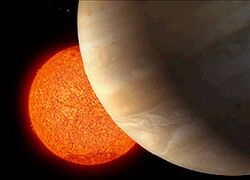Astronomy:Iota Draconis b
 Artist's concept of Iota Draconis b (foreground) orbiting its parent star (center). | |
| Discovery | |
|---|---|
| Discovered by | Frink et al. |
| Discovery date | January 8, 2002 |
| Doppler Spectroscopy | |
| Orbital characteristics[2] | |
| 1.453±0.026 astronomical unit|AU | |
| Eccentricity | 0.7010+0.0016 −0.0017 |
| Orbital period | 1.398643 ± 0.000035 a (510.854 ± 0.013 d) |
| Inclination | 46+27 −19 |
| Longitude of ascending node | 87+64 −60 |
| astron|astron|helion}} | 2455590.17±0.13 |
| 89.90±0.30 | |
| Semi-amplitude | 307.6 (± 2.3) |
| Star | Iota Draconis |
| Physical characteristics | |
| Mass | 16.4+9.3 −4.0 Jupiter mass[2] |
Iota Draconis b, formally named Hypatia (pronounced /haɪˈpeɪʃiə/ or /hɪˈpeɪʃə/), is an exoplanet orbiting the K-type giant star Iota Draconis about 101.2 light-years (31 parsecs, or nearly 2.932×1014 km) from Earth in the constellation Draco. The exoplanet was found by using the radial velocity method, from radial-velocity measurements via observation of Doppler shifts in the spectrum of the planet's parent star. It was the first planet discovered orbiting a giant star.[3]
Physical characteristics
Mass
Iota Draconis b is a "super-Jupiter", a planet that has mass larger than that of the gas giants Jupiter and Saturn. It has an estimated minimum mass of around 11.82 MJ.[2]
In 2021, astrometric observations revealed the true mass of Iota Draconis b to be 16.4 |♃|J}}}}}}.[2]
Host star
The planet orbits a (K-type) giant star named Edasich (designated Iota Draconis). The star has exhausted the hydrogen supply in its core and is currently fusing helium. The star has a mass of 1.82 M☉ and a radius of around 12 R☉. It has a surface temperature of 4545 K and is around 800 million years old based on its evolution. Although much younger than the Sun, the higher mass of this star correlates to a faster evolution, leading to the host star having already departed from the main sequence. When on the main sequence, Edasich was probably a Class A star with surface temperature between 7,400 and 10,000K.[4] In comparison, the Sun is about 4.6 billion years old[5] and has a surface temperature of 5778 K.[6]
The star's apparent magnitude, a measure of how bright it appears from Earth, is 3.31. Therefore, Edasich can be seen with the naked eye.
Orbit
Iota Draconis b orbits its star with nearly 55 times the Sun's luminosity (55 L☉) every 511 days at an average distance of 1.275 AU (compared to Mars' orbital distance from the Sun, which is 1.52 AU) It has a very eccentric orbit, with an eccentricity of 0.7124.
Discovery
Discovered in 2002 during a radial velocity study of K-class giant stars, its eccentric orbit aided its detection, as giant stars have pulsations which can mimic the presence of a planet.[3]
Name
Following its discovery the planet was designated Iota Draconis b. In July 2014, the International Astronomical Union launched NameExoWorlds, a process for giving proper names to certain exoplanets and their host stars.[7] The process involved public nomination and voting for the new names.[8] In December 2015, the IAU announced that the winning name for this planet was Hypatia.[9] The winning name was submitted by Hypatia, a student society of the Physics Faculty of the Universidad Complutense de Madrid, Spain . Hypatia was a famous Greek astronomer, mathematician, and philosopher.[10]
References
- ↑ Butler, R. P.; Wright, J. T.; Marcy, G. W.; Fischer, D. A.; Vogt, S. S.; Tinney, C. G.; Jones, H. R. A.; Carter, B. D. et al. (2006). "Catalog of Nearby Exoplanets". The Astrophysical Journal 646 (1): 505–522. doi:10.1086/504701. Bibcode: 2006ApJ...646..505B. http://www.iop.org/EJ/article/0004-637X/646/1/505/64046.html. Retrieved 2009-03-11.
- ↑ 2.0 2.1 2.2 2.3 Hill, Michelle L.; Kane, Stephen R.; Campante, Tiago L.; Li, Zhexing; Dalba, Paul A.; Brandt, Timothy D.; White, Timothy R.; Pope, Benjamin J. S. et al. (2021), "Asteroseismology of iota Draconis and Discovery of an Additional Long-period Companion", The Astronomical Journal 162 (5): 211, doi:10.3847/1538-3881/ac1b31, Bibcode: 2021AJ....162..211H
- ↑ 3.0 3.1 Frink; Mitchell, David S.; Quirrenbach, Andreas; Fischer, Debra A.; Marcy, Geoffrey W.; Butler, R. Paul (2002). "Discovery of a Substellar Companion to the K2 III Giant Iota Draconis". The Astrophysical Journal 576 (1): 478–484. doi:10.1086/341629. Bibcode: 2002ApJ...576..478F. http://www.iop.org/EJ/article/0004-637X/576/1/478/55741.html.
- ↑ Safonova, M.; Murthy, J.; Shchekinov, Yu. A. (2014). "Age Aspects of Habitability". International Journal of Astrobiology 15 (2): 93–105. doi:10.1017/S1473550415000208. Bibcode: 2016IJAsB..15...93S.
- ↑ Fraser Cain (16 September 2008). "How Old is the Sun?". Universe Today. http://www.universetoday.com/18237/how-old-is-the-sun/.
- ↑ Fraser Cain (September 15, 2008). "Temperature of the Sun". Universe Today. http://www.universetoday.com/18092/temperature-of-the-sun/.
- ↑ NameExoWorlds: An IAU Worldwide Contest to Name Exoplanets and their Host Stars. IAU.org. 9 July 2014
- ↑ "NameExoWorlds The Process". http://nameexoworlds.iau.org/process.
- ↑ Final Results of NameExoWorlds Public Vote Released, International Astronomical Union, 15 December 2015.
- ↑ "NameExoWorlds The Approved Names". http://nameexoworlds.iau.org/names.
External links
Coordinates: ![]() 15h 24m 55.7747s, +58° 57′ 57.836″
15h 24m 55.7747s, +58° 57′ 57.836″
 |

